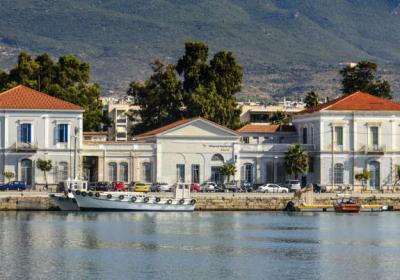
Kalamata Guide
The central point of the port is Teloneiou (Customs Office) Square, where the prominent buildings ofThe central point of the port is Teloneiou (Customs Office) Square, where the prominent buildings ofthe Customs Office and the Port Authority, a complex of eclectic and neoclassical features, are located.The Port Park, the beginning of Aristomenous street and the Municipal Railway Park are situated justbehind these buildings. West of the square, in just a few minutes walking distance, one can find thecity’s marina, which is a docking place for many boats (private or rented) and the location of manyrestaurants.
On that same side there are two buildings that remind us of the city’s industrial andOn that same side there are two buildings that remind us of the city’s industrial andcommercial past and the time when the port was a nationally significant trade hubbustling with merchants:
- The Autonomous Raisin Organization building, the design of which was based onFrench examples, was erected at a time when the trade of raisins (currants) wasthriving (in the early 20th century)
- The Roller Mills of Messinia “Evangelistria”, which were founded in 1925 and shutdown in 1991.East of the jetty, there is a beach extending for 2.5 km, ideal not only for strollingbut also for swimming in its crystal clear waters.
All along the beach line, on the vibrant, full-of-life (especially during the summerAll along the beach line, on the vibrant, full-of-life (especially during the summermonths) Navarinou street, one can find traditional but also contemporarydining places. There are also many modernly designed hotels, offeringtop-quality services that satisfy all clients’ needs, from simple accommodationto hosting large conferences.



















